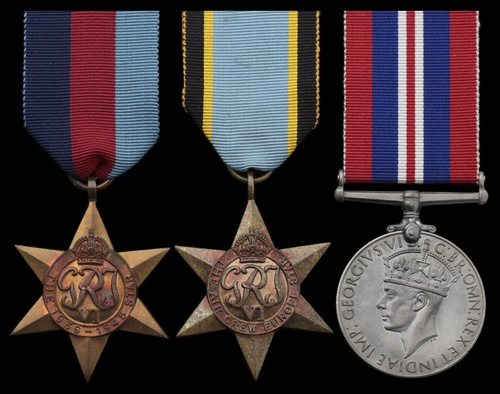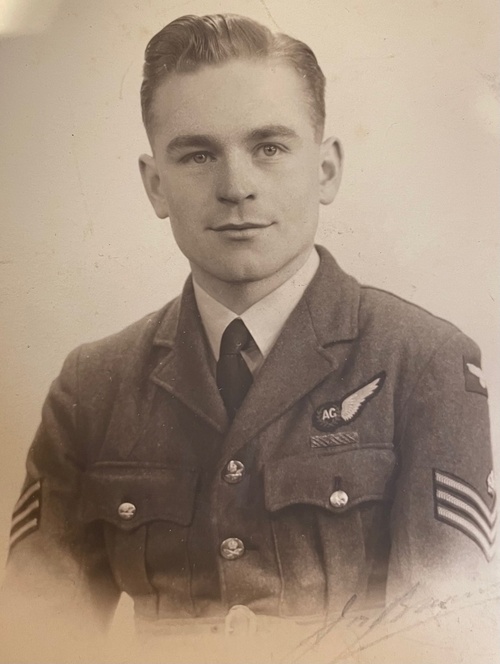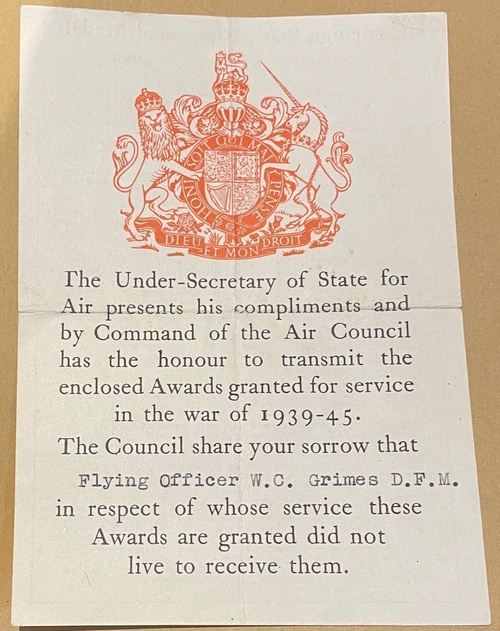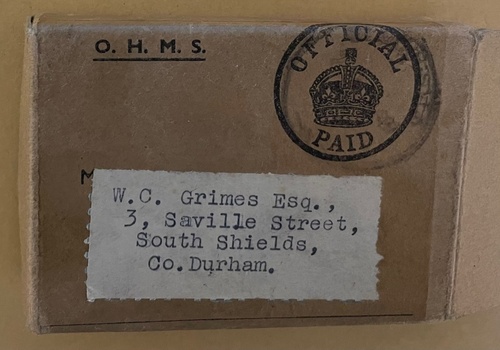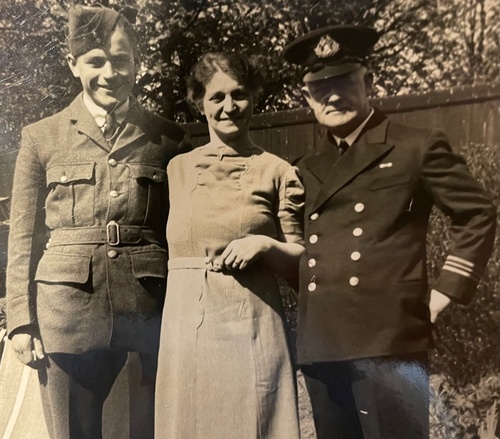Auction: 22003 - Orders, Decorations and Medals
Lot: 313
(x) Three: Flying Officer (Wireless Operator / Air Gunner) W. C. Grimes, D.F.M., No. 617 (Dambusters) Squadron, Royal Air Force Volunteer Reserve, who was killed in action when his Lancaster was lost without trace whilst in transit over the Iberian Peninsula and the Bay of Biscay, on 17-18 October 1943, having previously raided the Antheor Viaduct - Grimes was himself a veteran of some 56 operational sorties, having previously flown with No. 103 Squadron in 1941 on his first tour, and No. 218 Squadron in 1942 on his second tour
1939-45 Star; Air Crew Europe Star; War Medal 1939-45, with named Air Council enclosure in the name of 'Flying Officer W. C. Grimes D.F.M.', in card box of issue, addressed to ‘W. C. Grimes Esq., 3 Saville Street, South Shields, Co. Durham’, extremely fine (4)
[D.F.M.] London Gazette 12 January 1943. The original Recommendation states:
‘Flight Sergeant Grimes, W. C., is a Wireless Operator / Air Gunner of 218 (Gold Coast) Squadron. Between June 1941 and November 1942 he carried out as many as 53 operational sorties embracing 299 hours of operational flying. During his two tours he has always displayed courage and technical skill of a very high order.
On 24 July 1941, his aircraft was flying in formation with two other Wellingtons during a daylight raid on the German Battleships in Brest Harbour. The formation was attacked by two Me.109s. Although one of the Wellingtons was lost in the first attack, the combined fire of the remaining aircraft was sufficient to drive off one of the German machines and to shoot the other down in flames.
In September 1942, on the return from Munich, Flight Sergeant Grimes’ aircraft was subjected to very accurate and very intense flak. The aircraft was hit, the 2nd Pilot and Engineer slightly wounded, while the Navigator, mistaking an order to “Stand By”, actually baled out. Flight Sergeant Grimes dressed the 2nd Pilot’s wounds and acted with him as deputy Navigator. On reaching the French coast, wireless navigation became possible and Flight Sergeant Grimes was able to direct his Captain who landed safely at Manston.
Flight Sergeant Grimes’ keenness, resolution, and technical adroitness are held in very high regard by the other Wireless Operators, to whom he never fails to give the benefit of his knowledge and experience. He is very strongly recommended for the award of the D.F.M.’
Walter Crawford Grimes served during the Second World War as a Wireless Operator / Air Gunner initially with No. 103 Squadron, flying Wellingtons. He commenced operational duties with the Squadron on 12 June 1941, with an attack on Osnabruck. Between June and the end of September 1941, when he finished his tour, he flew in 28 operational sorties - targets included Brest Harbour (three times), Duisburg (twice), Cologne (five times), Bremen, Frankfurt (four times), Hamburg (five times), Mannheim (twice), and Berlin.
Transferring to No. 218 Squadron, flying Stirlings, he commenced his second tour of operational sorties on 29 May 1942, with an attack on Borkum, and the following night took part in the 1,000 Bomber Raid on Cologne. Between June and the beginning of November 1942, when he finished his tour, he flew in 25 operational sorties - targets included Essen (three times), Bremen (five times), St. Nazaire, Lubeck, Duisburg, Hamburg, Dusseldorf, Lubeck, Keil, Cologne, and Munich on 19 September 1942. It was on this sortie to Munich on 19 September that his aircraft was hit by intense flak, the 2nd pilot and engineer were wounded and the navigator bailed out. Grimes dressed the wounds of the injured crew and took over as deputy navigator. It was for this action, as well as previous good work over his two tours, that he was awarded the Distinguished Flying Medal.
Grimes was then rested to training and returned for his third tour with No. 617 ‘Dambusters’ Squadron. On 11 November 1943, Grimes’ Lancaster was one of eleven aircraft detailed to attack the Antheor Viaduct again using 12,000lb High Capacity thin-walled ‘Tall Boy’ bombs and new gyro bomb sights. Flying on to Blida Airfield in North Africa, Grimes and his crew were scheduled to return on 17-18 November, routed out over the Bay of Biscay. Grimes was killed in action on this flight when Lancaster ED735, piloted by Flight Lieutenant E. E. G. Youseman, D.F.C., and crewed by a very experienced crew that contained no fewer than four D.F.M. recipients, was lost without trace, having probably falling victim to enemy fighters over the Bay. All the crew were killed.
Grimes is commemorated on the Runnymede Memorial. His medals were sent to his father, also called Walter Crawford Grimes; sold together with several original images of the recipient and copied research.
For the Medal of his father, please see Lot 157.
Subject to 5% tax on Hammer Price in addition to 20% VAT on Buyer’s Premium.
Sold for
£650
Starting price
£480

